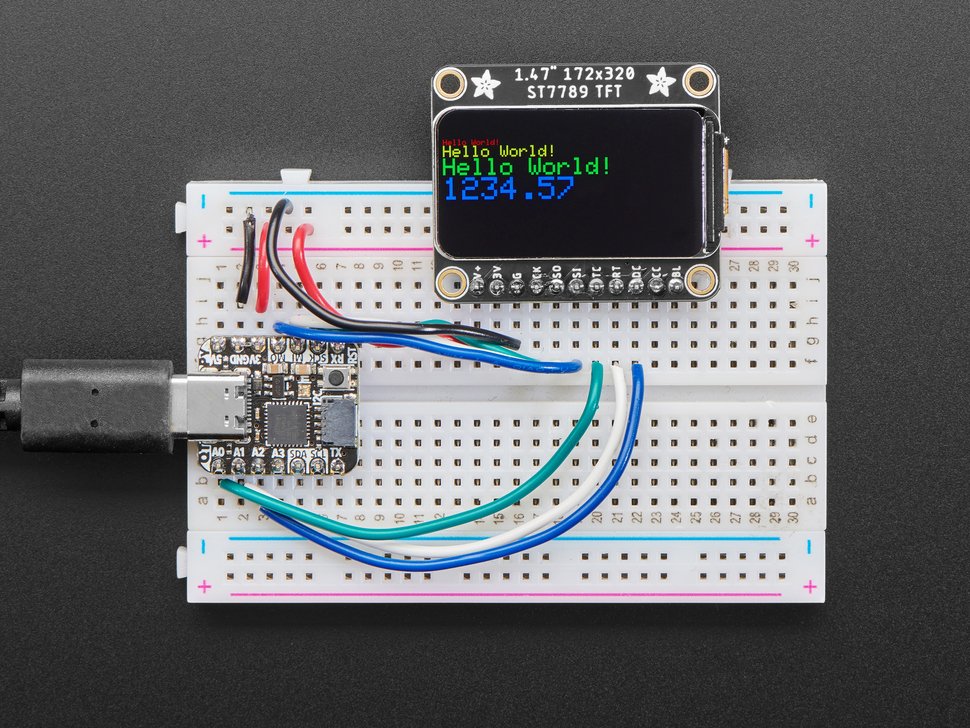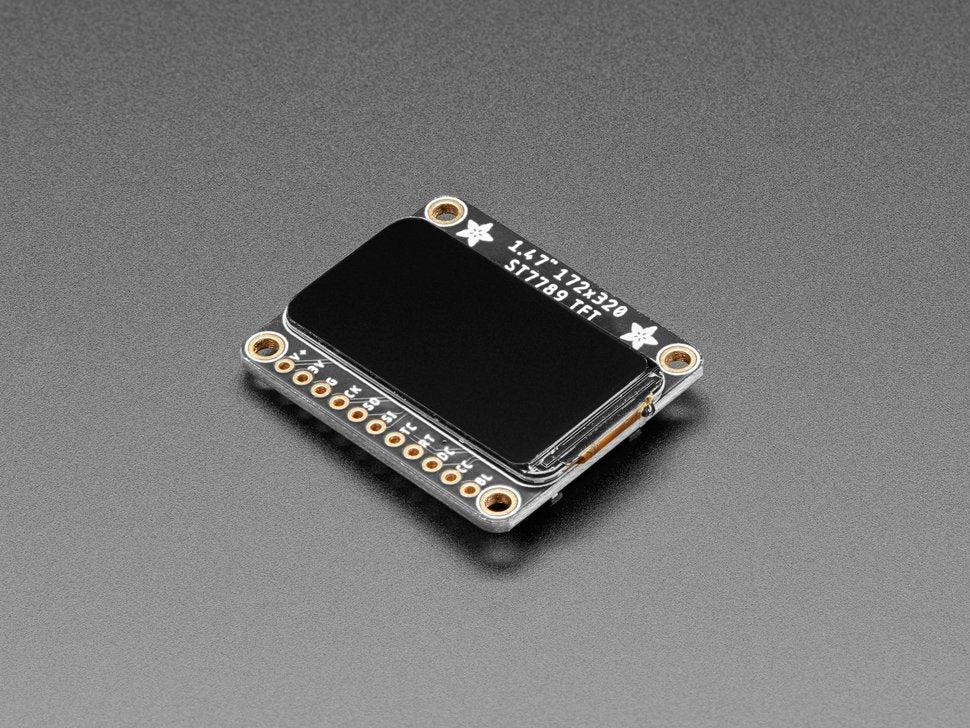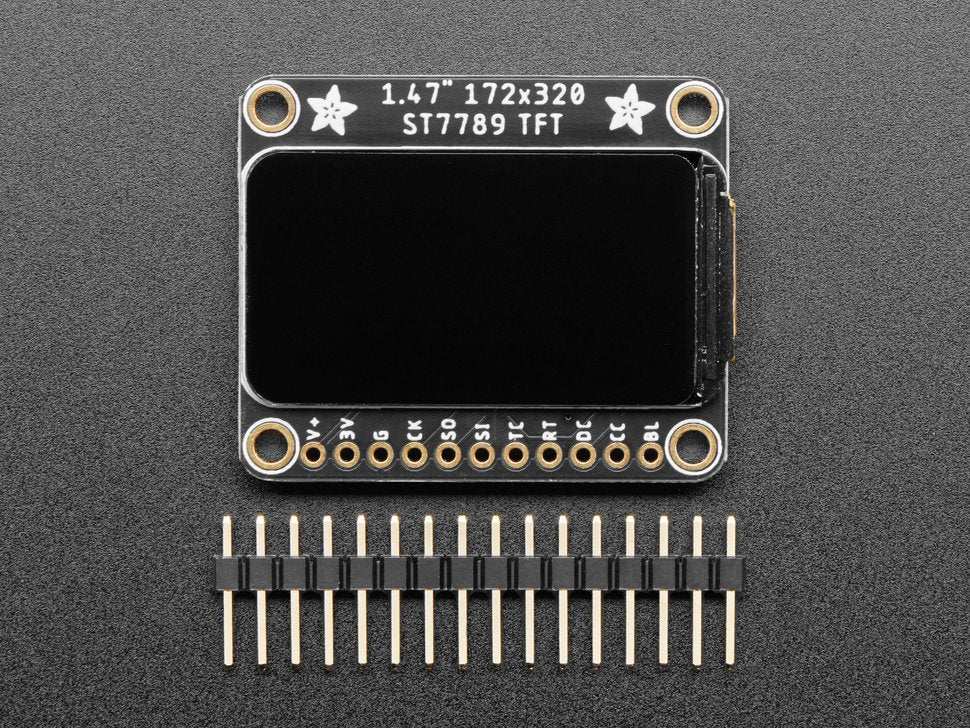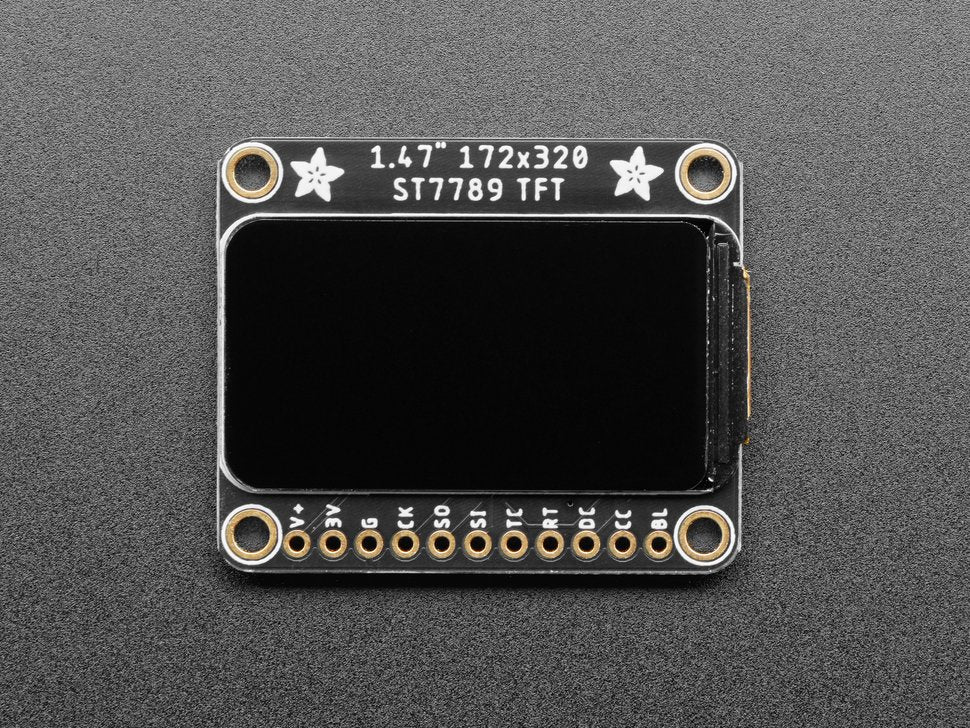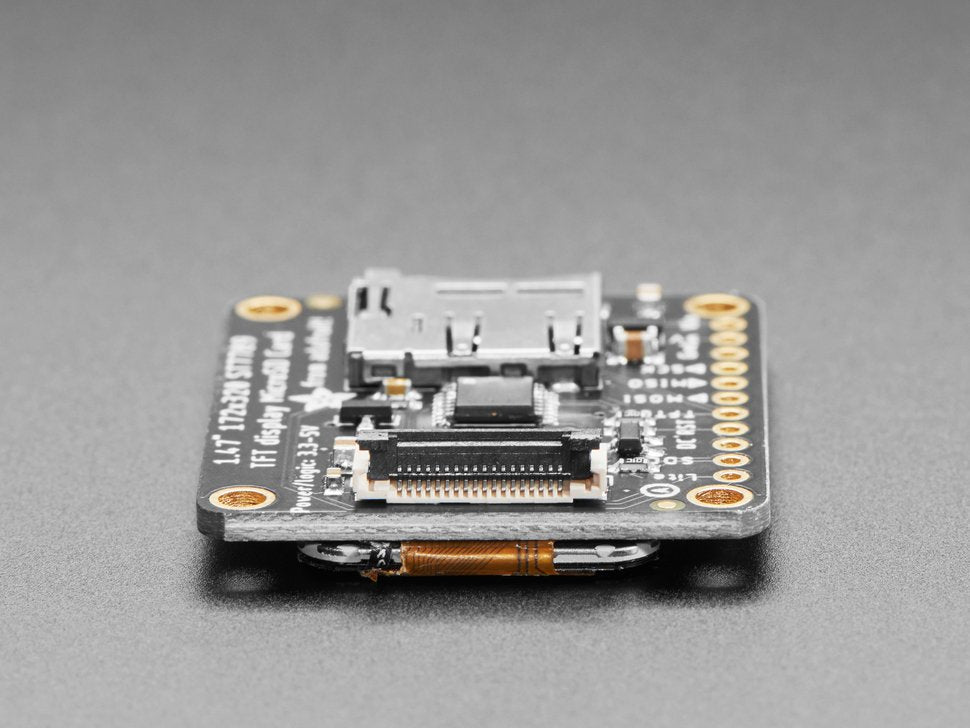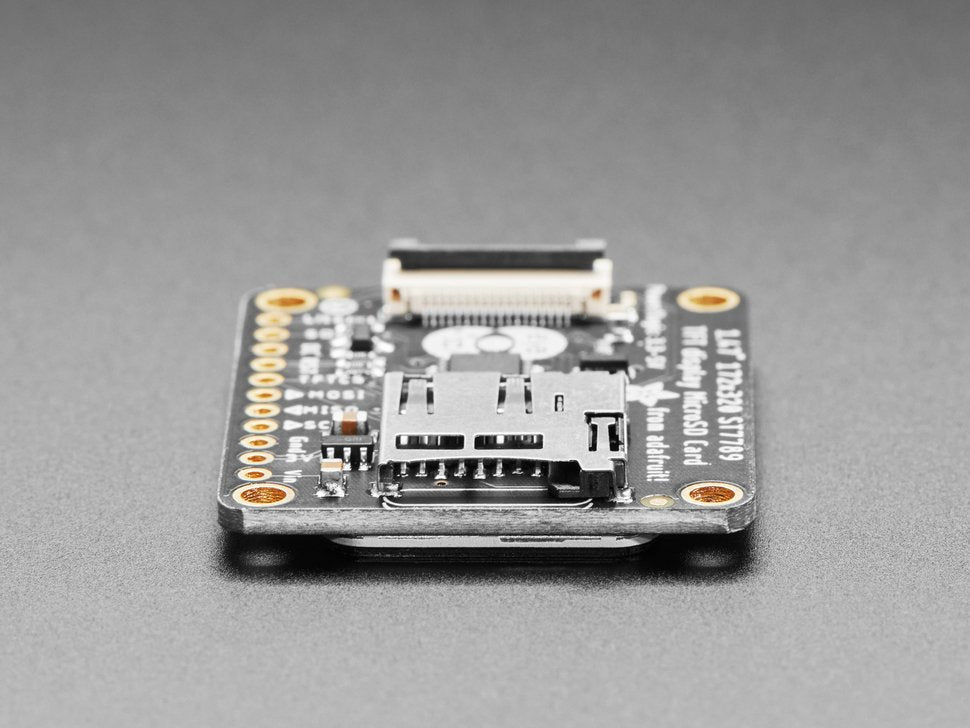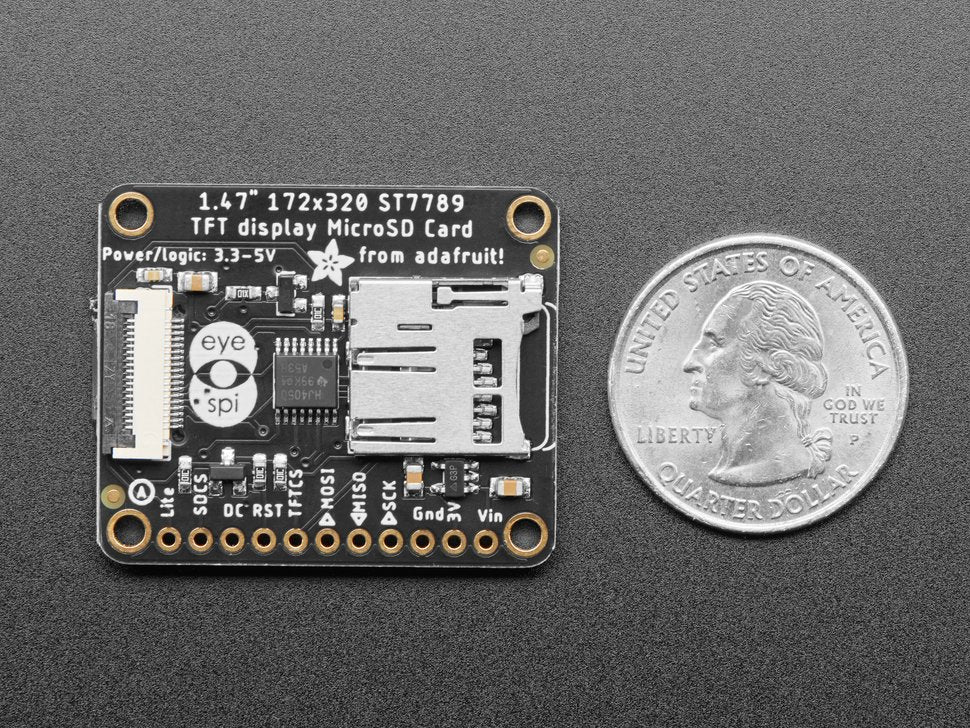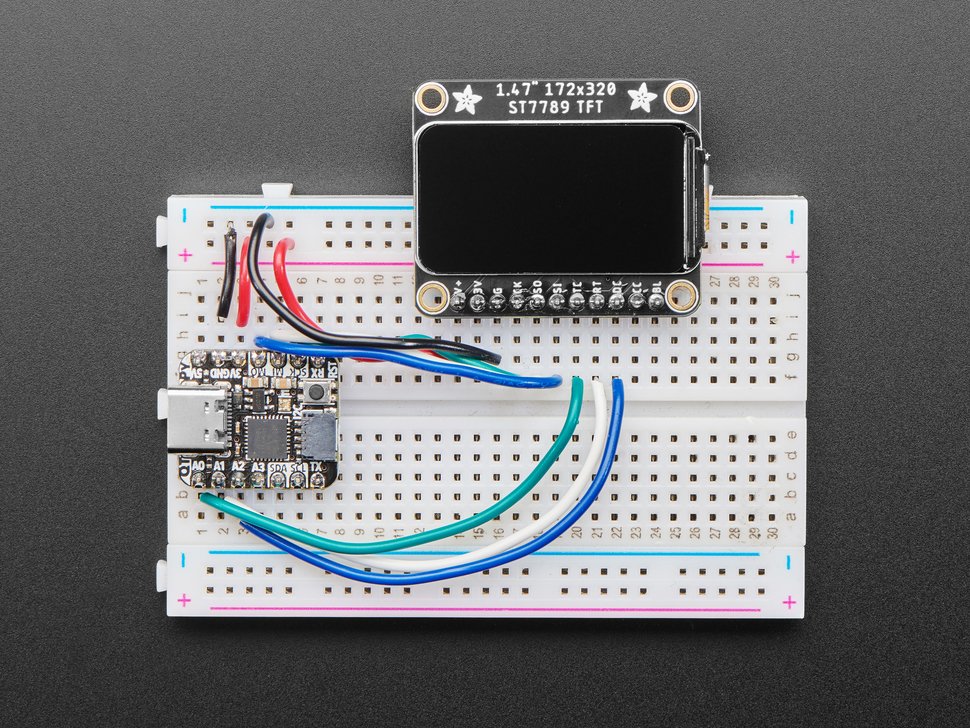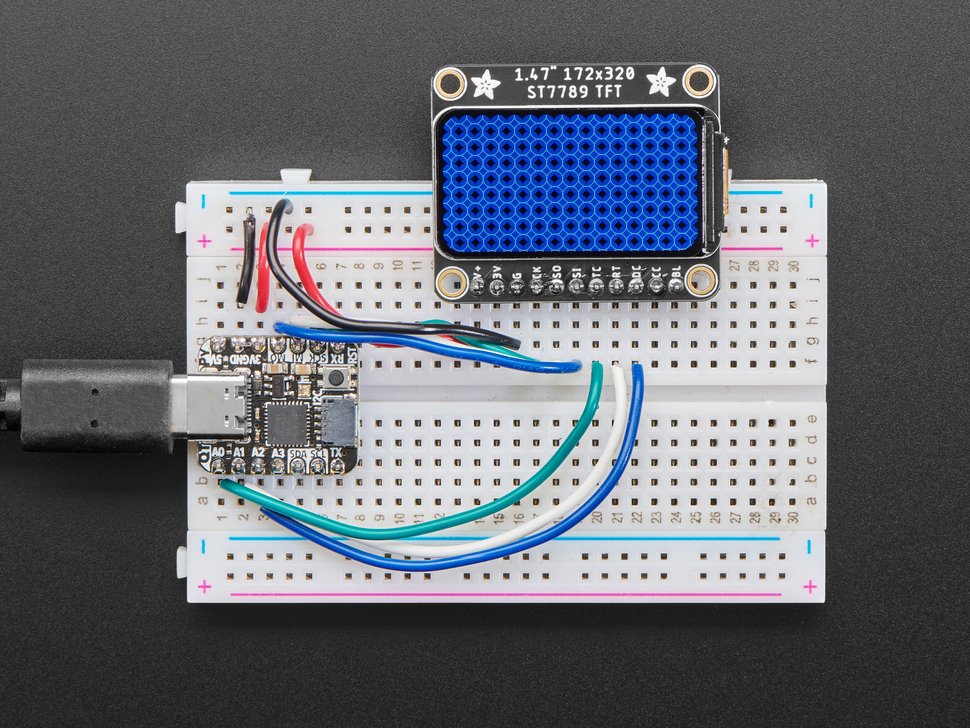Seien Sie nicht so spießig - werfen Sie einen Curveball auf Ihre Elektronik mit einem Miniatur-Display mit gebogenem Rand. Hier ist ein neues "Round-Rect"-TFT-Display mit einer Diagonale von 1,47 Zoll und einer hohen Pixeldichte von 250 ppi, 172x320 vollfarbigen Pixeln und IPS-Anzeige für jeden Blickwinkel. Es gab schon Displays dieses Kalibers in Smartwatches und kleinen elektronischen Geräten, aber sie hatten immer eine MIPI-Schnittstelle. Endlich hat Adafruit eines gefunden, das SPI ist und einen freundlichen Display-Treiber hat, so dass es mit allen Mikrocontrollern oder Mikrocomputern funktioniert!
Dieses hübsche kleine Display-Breakout ist der beste Weg, um ein kleines, farbenfrohes und sehr helles Display zu jedem Projekt hinzuzufügen. Da das Display über 4-Draht-SPI kommuniziert und einen eigenen pixeladressierbaren Framebuffer hat, kann es mit jeder Art von Mikrocontroller verwendet werden. Sogar mit einem sehr kleinen Mikrocontroller mit wenig Speicher und wenigen verfügbaren Pins! Das 1,47-Zoll-Display hat 172x320 16-Bit-Vollfarbpixel und ist ein IPS-Display, so dass die Farbe bis zu 80 Grad außerhalb der Achse in jeder Richtung gut aussieht. Der TFT-Treiber (ST7789) ist dem beliebten ST7735 sehr ähnlich, und Adafruits Arduino-Bibliothek unterstützt ihn gut.
Beachten Sie, dass die abgerundeten Ecken durch das Löschen von Pixeln erreicht werden. Die Eckpixel werden immer noch im RAM adressiert, sie werden nur nicht angezeigt, also ist es nicht so, dass man ein spezielles Radial-Pixel-Mapping machen muss. Behandeln Sie es wie ein rechteckiges Display.
Auf dem Breakout ist das TFT-Display aufgelötet (es verwendet einen empfindlichen Flex-Circuit-Anschluss) sowie ein 3,3-V-Regler mit extrem niedrigem Dropout, eine Auto-Reset-Schaltung und ein 3/5-V-Level-Shifter, so dass Sie es mit 3,3-V- oder 5-V-Strom und Logik verwenden können. Da wir etwas mehr Platz zur Verfügung hatten, haben wir einen microSD-Kartenhalter eingebaut, mit dem Sie ganz einfach farbige Bitmaps von einer FAT16/FAT32-formatierten microSD-Karte laden können. Die microSD-Karte ist nicht im Lieferumfang enthalten, aber Sie können sie hier erwerben.
Natürlich werden Sie nicht einfach mit einem Datenblatt und einem "Viel Glück!" zurückgelassen. - Adafruit hat eine vollständige Open-Source-Grafikbibliothek für Arduino geschrieben, die Pixel, Linien, Rechtecke, Kreise, Text und Bitmaps zeichnen kann, sowie einen Beispielcode. Der Code ist für Arduino geschrieben, kann aber leicht auf Ihren bevorzugten Mikrocontroller portiert werden! Die Verdrahtung ist einfach, wir empfehlen dringend, die Hardware-SPI-Pins Ihres Arduino zu verwenden, da Software-SPI bei dieser Displaygröße deutlich langsamer ist. Für Raspberry Pi oder andere Einplatinencomputer Python-Benutzer hatt Adafruit eine Pillow-kompatible Bibliothek für den Benutzerbereich. Für CircuitPython gibt es einen Displayio-Treiber für native Unterstützung.
Dieses Display-Breakout verfügt auch über einen 18-poligen "EYE SPI"-Standard-FPC-Anschluss mit einem Flip-Top-Anschluss. Sie können ein 18-poliges FPC-Kabel mit 0,5 mm Abstand verwenden, um alle GPIO-Pins anzuschließen, wenn Sie sich das Löten sparen wollen.
Bitte beachten Sie! Dieses Display ist ursprünglich für Smartwatches und ähnliche Geräte gedacht, bei denen ein Glas über dem Bildschirm liegt. Ohne etwas, das den Bildschirm sanft nach unten hält, kann sich die Hintergrundbeleuchtung schließlich vom TFT ablösen. (Es ist zerstört das Display nicht, aber es ist unschön) Sie können dies verhindern, indem Sie idealerweise eine Kunststoff- oder Glasabdeckung/Overlay hinzufügen. Wenn Sie das Gerät unverkleidet verwenden, tupfen Sie etwas E6000 oder einen ähnlichen Bastelkleber auf die dünnen Seitenränder, oder verwenden Sie ein dünnes Stück Klebeband, um das TFT auf der Vorderseite mit der Hintergrundbeleuchtung zu verbinden.
Technische Daten
- 1,47-Zoll-LCD-TFT-Bildschirm
- Eingebauter microSD-Steckplatz
- 1x11 Header für einfaches Breadboarding
- 4 x 0.1" / 2.5mm Befestigungslöcher in den Ecken
- TFT-Bildschirm-Abmessungen: 34mm x 19.4mm / 1.3" x 0.76"
- Gesamtabmessungen: 37mm x 30,5mm / 1,4" x 1,2"
- Befestigungslöcher: 1,2" x 1,0""
EYE SPI 18-Pin FPC-Anschluss
- VIN (3 bis 5V DC Stromversorgung)
- Hintergrundbeleuchtung (3~5V logischer PWM-Eingang optional)
- Masse
- SPI-Takt (3~5V Logikeingang)
- SPI MOSI (3~5V Logik Mikrocontroller Ausgang, Bildschirm/SD Eingang)
- SPI MISO (3~5V Logik Mikrocontroller Eingang, Bildschirm/SD Ausgang)
- TFT Daten/Befehle (3~5V Logik Eingang)
- TFT Reset (optionaler 3~5V Logikeingang)
- TFT SPI Chip Select (3~5V logischer Eingang)
- SD-Karten-SPI-Chipauswahl (3~5V logischer Eingang)
- Unbenutzt
- Unbenutzt
- Unbenutzt
- Unbenutzt
- Unbenutzt
- Unbenutzt
- Unbenutzt
- Unbenutzt
Produkt-Abmessungen: 37,3mm x 30,5mm x 5,4mm / 1,5" x 1,2" x 0,2"
Produktgewicht: 6.7g / 0.2oz
English Description
Don't be such a square - throw a curveball into your electronics with a curved-edge miniature display. Here's a new "round rect" TFT display - it's 1.47" diagonal and has high-density 250 ppi, 172x320 full-color pixels with IPS any-angle viewing. We've seen displays of this caliber used in smartwatches and small electronic devices, but they've always been MIPI interface. Finally, we found one that is SPI and has a friendly display driver, so it works with any and all microcontrollers or microcomputers!
This lovely little display breakout is the best way to add a small, colorful, and very bright display to any project. Since the display uses 4-wire SPI to communicate and has its own pixel-addressable frame buffer, it can be used with every kind of microcontroller. Even a very small one with low memory and few pins available! The 1.47" display has 172x320 16-bit full color pixels and is an IPS display, so the color looks great up to 80 degrees off-axis in any direction. The TFT driver (ST7789) is very similar to the popular ST7735, and our Arduino library supports it well.
Note that the way we get the rounded corners is by deleting pixels. The corner pixels are still addressed in RAM, they just don't appear, so it isn't like you have to do some special radial-pixel mapping. Treat it like a rectangular display.
The breakout has the TFT display soldered on (it uses a delicate flex-circuit connector) as well as an ultra-low-dropout 3.3V regulator, auto-reset circuitry, and a 3/5V level shifter so you can use it with 3.3V or 5V power and logic. We also had a little extra space, so we placed a microSD card holder so you can easily load full color bitmaps from a FAT16/FAT32 formatted microSD card. The microSD card is not included, but you can pick one up here.
Of course, we wouldn't just leave you with a datasheet and a "good luck!" - we've written a full open-source graphics Arduino library that can draw pixels, lines, rectangles, circles, text, and bitmaps as well as example code. The code is written for Arduino but can be easily ported to your favorite microcontroller! Wiring is easy, we strongly encourage using the hardware SPI pins of your Arduino as software SPI is noticeably slower when dealing with this size display. For Raspberry Pi or other Single Board Computer Python users, we have a user-space Pillow-compatible library. For CircuitPython there's a displayio driver for native support.
This display breakout also features an 18-pin "EYE SPI" standard FPC connector with a flip-top connector. You can use an 18-pin 0.5mm pitch FPC cable to connect to all the GPIO pins, for when you want to skip the soldering.
Please note! This display is designed original for smartwatches and similar, where there's a glass over the screen. Without something gently holding the screen down, the backlight can eventually peel away from the TFT. (It's not destructive but it's unattractive) You can prevent this by, ideally, adding a plastic or glass cover/overlay. If using bare, try dabbing a touch of E6000 or similar craft glue on the thin side edges, or using a thin piece of tape to keep the front TFT attached to the backlight.
Technical Details
Specifications:
- 1.47" LCD TFT display
- Built-in microSD slot
- 1x11 header for easy breadboarding
- 4 x 0.1" / 2.5mm mounting holes in corners
- TFT screen dimensions: 34mm x 19.4mm / 1.3" x 0.76"
- Overall dimension: 37mm x 30.5mm / 1.4" x 1.2"
- Mounting holes: 1.2" x 1.0""
EYE SPI 18-pin FPC Connector:
- VIN (3 to 5V DC power)
- Backlight (3~5V logic PWM optional input)
- Ground
- SPI Clock (3~5V logic in)
- SPI MOSI (3~5V logic Microcontroller Out, Screen/SD In)
- SPI MISO (3~5V logic Microcontroller In, Screen/SD Out)
- TFT Data/Command (3~5V logic in)
- TFT Reset (optional 3~5V logic in)
- TFT SPI Chip Select (3~5V logic in)
- SD Card SPI Chip Select (3~5V logic in)
- Unused
- Unused
- Unused
- Unused
- Unused
- Unused
- Unused
- Unused
Product Dimensions: 37.3mm x 30.5mm x 5.4mm / 1.5" x 1.2" x 0.2"
Product Weight: 6.7g / 0.2oz
Sicherheitsangaben
- Lesen Sie die Bedienungsanleitung sorgfältig durch, bevor Sie das Produkt verwenden.
- Stellen Sie sicher, dass alle Montage- und Installationsanweisungen des Herstellers sorgfältig befolgt werden.
- Verwenden Sie das Produkt nur für den vorgesehenen Zweck.
- Die unsachgemäße Nutzung dieses Produkts kann zu schweren Verletzungen oder Sachschäden führen.
- Nicht für Kinder unter 10 Jahren geeignet.
- Bei unsachgemäßer Verwendung besteht eine Verletzungsgefahr.
- Dieses Produkt entspricht den geltenden Sicherheitsanforderungen der Europäischen Union.
- Dieses Produkt wurde gemäß der GPSR geprüft, die sicherstellt, dass alle relevanten Sicherheitsanforderungen für Konsumgüter eingehalten werden.
Nachverfolgbarkeitsinformationen
Jedes Produkt verfügt über eines oder mehrere der folgenden Merkmale:
- Ein CE-Kennzeichen, das die Einhaltung der Sicherheits-, Gesundheits- und Umweltschutzanforderungen der Europäischen Union anzeigt.
- Eine eindeutige Serien- oder Chargennummer, um die Nachverfolgbarkeit zu gewährleisten und bei Bedarf Rückrufaktionen zu unterstützen.
- Hersteller- und Importeurangaben für den Kundensupport und Sicherheitsanfragen.
Überwachung und Berichterstattung von Vorfällen
Für den unwahrscheinlichen Fall eines Produktproblems haben wir Verfahren implementiert, um:
- Kundenbeschwerden zeitnah bearbeiten.
- Schwerwiegende Vorfälle über das EU Safety Gate/RAPEX-System melden.
- Mit den Marktüberwachungsbehörden zusammenarbeiten, um die öffentliche Sicherheit zu gewährleisten.
Kontakt:
- Email: support [@] pi3g.com
- Telefon: 0341 / 392 858 40
Dieses Produkt ist vollständig mit allen geltenden EU-Vorschriften konform, um die Sicherheit unserer geschätzten Kunden zu gewährleisten.

